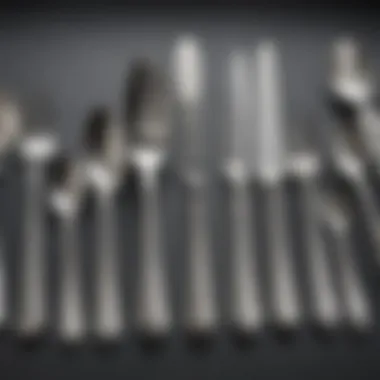Optimal Strategies for Loading Silverware in the Dishwasher


Intro
Loading silverware in the dishwasher may appear to be a straightforward task, however, there are strategic methods that can enhance both cleanliness and longevity of your utensils. Understanding how to properly position and organize your silverware can make a significant difference in their maintenance and overall hygiene. This article will provide insights into the mechanics of dishwashers, the importance of water flow, and the best practices for loading varied types of silverware.
Key Points
- Dishwasher Mechanics: Learn about how dishwashers operate and how different designs affect cleaning effectiveness.
- Water Pressure and Temperature: Understand how these factors impact the cleanliness of silverware and how they can be optimized.
- Loading Techniques: Discover specific techniques for various types of silverware to enhance cleaning.
- Maintenance Tips: Understand how proper loading can prolong the life of your utensils.
By implementing the strategies outlined in this article, you can ensure that your silverware not only comes out clean but also remains in great condition for years to come.
Understanding Dishwasher Mechanics
Understanding how dishwashers operate is pivotal in optimizing the loading of silverware. The efficiency of this household appliance hinges on its mechanics, which include water pressure, heat application, and the pathway water takes within the machine. By grasping these fundamental principles, you can ensure that your silverware not only comes out clean but also remains in pristine condition, extending its longevity.
The Role of Water Pressure
Water pressure is a crucial factor in the cleaning process. Dishwashers utilize a combination of high pressure and directed spray to reach every inch of your plates, glasses, and silverware. The effectiveness of cleaning primarily depends on the pressure with which water is shot from spray arms. When loading silverware, it is essential to allow space between utensils, enabling the water streams to circulate freely. If silverware is crowded together, pockets of food debris might remain, leading to unsatisfactory cleaning results. Inadequate water pressure can arise from improper loading or blocked spray arms, making it vital to follow optimal loading techniques.
Heat and Its Impact on Cleaning
Heat plays an equally important role in the cleaning dynamics of your dishwasher. The heating element in the machine raises the temperature of the water, activating cleaning agents in the detergent and helping to dissolve and remove grease and stubborn food residues. Different materials react variably to heat, so when loading silverware, it’s wise to consider the heat resistance of each type. For instance, stainless steel can withstand high temperatures, while silver-plated items are more sensitive. The wrong heat exposure may tarnish or damage delicate finishes. Thus, selecting the right wash cycle based on the materials used is crucial for preserving the integrity of your silverware.
The Path of Water in a Dishwasher
The journey of water within a dishwasher begins from the fill valve, which controls the amount of water entering the machine. Once filled, the water is heated and directed through spray arms that rotate to clean all surfaces of the dishes. Understanding this path can guide how you load your silverware. For optimal results, silverware should be positioned in such a way that the spray arms can reach it without obstruction. It is advisable to load utensils with the handles facing downward. This orientation prevents water from pooling in any crevices and ensures complete rinsing of surfaces. By appreciating the mechanics involved, users can tailor their loading approach to enhance the cleaning process.
Types of Silverware
Understanding the various types of silverware is essential when loading them into the dishwasher. The material composition of utensils directly impacts their cleaning requirements and potential for damage. Each type has unique caracteristics that dictate how best to care for them during the washing process. This section will detail the three main categories of silverware: stainless steel, silver-plated utensils, and plastic or composite materials. Grasping these distinctions will ultimately enhance cleaning effectiveness and extend the lifespan of these items.
Stainless Steel
Stainless steel is widely regarded as the most durable and versatile type of silverware. It has a high resistance to rust and corrosion, making it an excellent choice for regular use. When loading stainless steel utensils into the dishwasher, it is important to take advantage of their sturdiness. Place them in the silverware basket facing downward. This method maximizes the cleaning potential by allowing water and detergent to reach all surfaces.
It is recommended to keep forks and knives separate to avoid scratching and maintain their edges. Additionally, ensure that stainless steel does not touch aluminum, as this can cause tarnishing and discoloration. Another consideration is the dishwasher's wash cycle. Using a high-temperature setting and a high-quality detergent optimized for stainless steel will yield optimal results.
Silver-Plated Utensils
Silver-plated utensils require more delicate handling compared to their stainless steel counterparts. The thin layer of silver can tarnish easily, especially when exposed to harsh detergents or high heat. To protect these items during the wash cycle, it is crucial to avoid placing them on the bottom rack, where the heat and pressure are highest.
Instead, load them gently in the silverware basket, ensuring that they do not touch other utensils to minimize scratching. A gentle cycle is preferable, along with a clear rinse that helps remove soap residues. It's also wise to pre-rinse silver-plated items to mitigate tarnishing. Consider hand washing high-value pieces to extend their elegance and sheen.
Plastic and Composite Materials
Plastic and composite materials are common choices for everyday utensils. They are lightweight and often dishwasher-safe, provided they are labeled as such. When loading plastic utensils, avoid the top rack for items labeled "top rack only," as the heat from the dishwasher's heating element can warp or damage them. Instead, load them securely in the silverware basket with the handles facing down, similar to stainless steel utensils.


Moreover, be cautious with highly pigmented plastics, as they can easily stain if subjected to long wash cycles or harsh detergents. When selecting a detergent, opt for one that is safe for plastics. An important note is that while plastic utensils are durable, they may not perform well under high stress, and thus, monitoring loading density can prevent damage.
Loading Techniques for Silverware
Loading silverware into the dishwasher requires thoughtful techniques. Following the proper methods can significantly improve cleaning effectiveness and ensure the longevity of your utensils. These strategies focus on ensuring that water and detergent reach all surfaces of the silverware, thus enhancing overall cleaning efficiency.
Facing Direction
The direction in which utensils face in the dishwasher plays a critical role in how effectively they are cleaned. It is advised to place forks, knives, and spoons with their handles downward and the eating surfaces facing upward. This allows water jets to effectively reach the surfaces that require the most cleaning. When the utensils are correctly oriented, they reduce the chance of food residues being trapped between them. Therefore, facing utensils correctly should be one of the first steps when loading the dishwasher.
Separation of Utensils
Keeping different types of utensils separate is essential. It prevents metal-on-metal contact while washing, which can lead to scratches or tarnishing, particularly for silver-plated items. Furthermore, keeping forks, knives, and spoons apart ensures that they do not nest within each other. It allows water and detergent to reach every surface of each piece. A practical way to achieve this is to load items into the designated silverware basket or rack in the dishwasher, allowing for organized separation.
Avoiding Nested Loading
Nested loading occurs when utensils become trapped inside one another during the wash cycle. This common mistake can severely hinder the effectiveness of the wash. Water cannot penetrate these tight spaces, leading to unwashed areas on your silverware. To avoid this issue, ensure that no two utensils are stacked on top of each other. Arranging utensils in a manner that allows gaps between items promotes water circulation and thorough cleaning. A good approach is to place utensils in alternating orientations to maximize exposure to water jets.
"Proper loading techniques are crucial for ensuring that your silverware comes out clean and undamaged."
Utilizing the Silverware Basket
The silverware basket is a crucial component in maximizing the efficiency of your dishwasher. Its design and functionality allow for effective cleaning of utensils, promoting optimal water flow and detergent distribution. Understanding how to use this basket properly can ensure that your silverware gets the cleansing it requires without the risk of damage or inefficient cleaning.
When loading silverware into the basket, the primary aim is to organize the utensils in a way that allows them to be cleaned thoroughly. Proper placement not only enhances cleaning performance but also reduces the likelihood of utensils clanking together, which can lead to scratches and other forms of wear. As such, familiarity with the features of the silverware basket is essential.
Placement Strategies Within the Basket
Placing silverware correctly within the basket is a fundamental practice that can make a difference in the wash. First, insert forks and spoons with the handles facing downward. This position ensures that the bowl of each spoon and the tines of each fork receive adequate exposure to water and detergent. Likewise, knives should be placed with handles down, although some users prefer to position them with blades facing downward for added safety.
- Keep similar items together: Group spoons, forks, and knives in separate compartments of the basket. This segregation not only clarifies what utensils are present but also facilitates rinsing.
- Avoid overcrowding: Leave space between each piece to prevent nesting. When utensils are too close together, they can block water from reaching all surfaces, compromising the cleaning effectiveness.
- Utilize all sections: Use all available sections of the basket to maximize loading space. Each section serves to hold more utensils and often has varying depths to accommodate different sizes.
Taking these steps seriously can improve the hygiene of your dining tools considerably.
Choosing the Right Basket for Your Silverware
Choosing an appropriate silverware basket is equally as important for achieving optimal results. Many dishwashers come with a standard basket; however, buying a specialized or replacement basket can offer improvements based on your needs. Here are several key considerations in selecting a silverware basket:
- Material Composition: Ensure that the basket is made from robust material. Plastic is common, but ensure it can withstand high temperatures without warping.
- Size and Configuration: Match the basket's size with the amount and types of silverware you frequently wash. Some baskets have flexible dividers, which can be useful for varying utensil sizes.
- Ease of Removal: Opt for baskets that are easy to detach for quick unloading. Some baskets feature ergonomic designs, which can simplify the process.
- Compatibility: Verify that the basket fits snugly within your dishwasher without causing interruptions. A poorly sized basket can obstruct water flow and disrupt the cleaning process.
Proper use of the silverware basket enhances not only washing effectiveness but also utensil longevity. The subtle choices made during loading can have a lasting impact on the condition of your cutlery.
Avoiding Common Mistakes
Loading silverware in the dishwasher is more complex than it may seem. Many users make errors that impede cleaning effectiveness or damage their utensils. Understanding these common mistakes can lead to better maintenance of silverware. Avoiding these pitfalls not only ensures a thorough clean but also prolongs the life of your valuable items. Below are specific mistakes to be aware of:
Omitting Pre-Rinsing


Pre-rinsing utensils can often be viewed as unnecessary or time-consuming. However, residues from food can become stubborn if left unaddressed before washing. When silverware is loaded in the dishwasher with dried food remnants, it may not receive adequate water pressure needed to clean effectively. Food particles can lead to cloudy surfaces on stainless steel or tarnishing on silver-plated items. Dishwashers are equipped to handle certain levels of debris; however, too much can inhibit their performance.
Some individuals may argue that modern detergents and dishwasher designs can handle un-rinsed silverware. While this is sometimes true, pre-rinsing is still a recommended step to ensure thorough cleaning. Rinsing can be as simple as a quick wash under running water. It not only aids in cleanliness but also prevents the unpleasant task of soaking stubborn residues later on.
Overloading the Dishwasher
Another common mistake is overloading the dishwasher. Users tend to think that cramming in as much silverware as possible will save time and energy. Unfortunately, this rarely leads to better cleaning results. When dishes and utensils are packed too tightly, the water cannot circulate effectively. This can leave certain items inadequately washed, with residues remaining.
A well-optimized loading strategy is essential. Ensure that silverware can move freely within the basket. Allowing space means that water can reach all surfaces. When loading, focus on the layout rather than sheer quantity. Consider running smaller loads to achieve a higher standard of cleanliness. Ultimately, less can be more when it comes to washing.
Mixing Different Types of Silverware
One should also avoid mixing various types of silverware. Combining stainless steel, silver-plated utensils, and plastic items in one load is a recipe for disaster. Different materials react uniquely in a dishwasher, which can create unwanted scratches or tarnishes amongst your utensils.
For example, stainless steel and silver-plated items can tarnish when they come into contact with each other due to the ionic properties of the metals. Some users might think that it is convenient to wash everything together. However, this negligence could ruin an expensive silver platter or delicate silverware. It is advisable to separate and group types of silverware before loading for the best outcome.
Always prioritize understanding your silverware materials for optimal cleaning results.
By keeping these points in mind, users can ensure their silverware not only comes out clean but also retains its integrity. Correct loading practices are essential for the lasting care of utensils.
Maintaining Silverware Longevity
Maintaining silverware longevity is vital for anyone looking to preserve the aesthetics and functionality of their utensils. Proper care ensures that your silverware stays in excellent condition, retaining its original luster and quality. This section focuses on how appropriate washing methods contribute to the overall lifespan of silverware. Each type of silverware may require specific considerations, but understanding general principles can lead to better decision-making regarding care and maintenance.
Choosing the Appropriate Wash Cycle
Selecting the right wash cycle is crucial for prolonging the life of silverware. Different cycles utilize various temperatures and durations, affecting how clean the utensils become without causing damage. For stainless steel, a standard wash cycle usually suffices. However, delicate items like silver-plated utensils need a gentler cycle. A light wash setting can prevent chipping and scratching. Avoid high-heat cycles, particularly for non-stainless materials, as they can lead to tarnishing or corroding.
When you choose the wash cycle, consider the following elements:
- Temperature Settings: Ensure the cycle won’t exceed the limitations of your silverware material.
- Duration: Shorter cycles are often preferable for fragile items.
- Rinse Options: Many modern dishwashers offer rinse aids that help minimize mineral deposits, which is beneficial for both the cleaning process and the final appearance.
Care for Silver-Plated Items
Silver-plated items necessitate extra attention to maintain their charm and minimize tarnishing. While these utensils can endure a dishwasher cycle, the quality is significantly impacted by the cycle chosen. Here are some practices to consider when cleaning silver-plated utensils:
- Use Mild Detergents: Choose dishwasher detergents that do not contain harsh chemicals. Heavy detergents can strip away the silver layer.
- Separate Loading: Keep silver-plated items separate from stainless steel utensils. This prevents metal reactions that can cause harm to the plating.
- Avoiding Air Drying: If possible, hand dry silver-plated items after washing. Air drying can lead to spots or tarnishing from minerals in the water.
- Regular Maintenance: Periodically polish silver-plated utensils to maintain their shine and prevent the build-up of tarnish.
"Proper care techniques can keep silverware looking like new for years and prevent costly replacements."
By implementing these strategies, one can significantly extend the lifespan of silverware and ensure that each piece retains its beauty and utility for many meals to come.
Dealing with Residue and Spotting
Dealing with residue and spotting is critical when using a dishwasher. Despite the convenience it provides, many users find that their silverware does not always come out spotless. Understanding how to effectively deal with these issues can drastically improve the cleaning outcomes of your utensils. This section will provide insights into important factors, examine product choices, and offer techniques that contribute to a more satisfactory wash.
Understanding Detergent Choices


Selecting the right detergent is pivotal to achieving clean and shiny silverware. Not all dishwashing detergents are created equal; some are specifically formulated to tackle tough residues while others may be gentler. The type of detergent you choose can impact the effectiveness of your washing.
- Powder Detergents: These are often more concentrated and can be effective at cutting through grime. They may require measuring, but users typically find that a small amount goes a long way.
- Gel Detergents: These tend to dissolve quickly, which helps avoid residue. They can offer convenience but sometimes may not be as effective on baked-on food compared to powders.
- Pods: Convenient and pre-measured, these have become popular. Some pods include rinse aids and can deliver consistent results, but occasionally they may not dissolve properly in certain water temperatures.
It's crucial to ensure that the detergent matches the cleaning requirements of your silverware, especially if they are silver-plated or consist of special materials. Always follow the manufacturer's guidelines to avoid damage and poor performance. To learn more about different detergents, Wikipedia provides comprehensive information on various brands and formulations.
Techniques for Preventing Water Spots
Water spotting is another common issue that can mar the appearance of your silverware. It often arises from hard water or poor drying methods. Here are some techniques to combat this problem effectively:
- Use Rinse Aids: Rinse aids help in reducing water spots by promoting better drainage and leaving a layer that reduces the surface tension of water. They are particularly helpful in hard water areas.
- Adjust Your Dishwasher Settings: Some models offer a "Heated Dry" option that can improve drying time. Using this option can help minimize the chance of spotting, especially for stainless steel.
- Load Properly: Ensuring that silverware is loaded correctly can minimize the chance of pooling water on surfaces. Keep knives, forks, and spoons separated and facing downwards.
- Towel Drying: If spots do appear, a quick dry with a soft cloth can help remove the marks and restore shine.
"Proper loading and using the right products can significantly enhance silverware cleaning results."
Understanding Dishwasher Models
Understanding different dishwasher models is key to optimizing how silverware is loaded and cleaned. Each model comes with unique quirks that can influence washing efficiency. Users must recognize how these variations affect the cleaning process and ultimately the care of their silverware.
Cycle Options by Model
Dishwashers are equipped with a variety of cycle options. Knowing what each model offers can guide users in selecting the most effective cycle for silverware. This can vary based on the age and brand of the dishwasher. Here are some common cycles:
- Normal Cycle: This is suitable for everyday loads. It offers a balanced approach, using average water pressure and temperature.
- Heavy Duty Cycle: Designed for tough stains and heavily soiled items. This cycle usually combines high water pressure with elevated temperatures.
- Light Cycle: A gentler wash that is ideal for delicate items, but may not remove stubborn residue effectively.
- Eco Mode: While it uses less water and energy, its longer washing time can make it less effective for heavily soiled silverware.
Selecting the right cycle is crucial. Using the wrong cycle might lead to insufficient cleaning or even damage to the silverware, particularly for more delicate items such as silver-plated utensils.
Features Affecting Performance
The performance of a dishwasher is influenced by several features. Buyers should assess these aspects while considering a model:
- Water Pressure: Higher pressure enhances cleaning efficacy. Models with adjustable spray arms can provide targeted pressure, crucial for effectively cleaning silverware.
- Filtration System: A good filtration system ensures that food particles don’t circulate during cycles. This is important for maintaining cleanliness in silverware loads.
- Heating Element: Some dishwashers have built-in heaters to maintain water temperature. Hot water aids in breaking down grease and residue.
- Drying Options: Different models come with varied drying capabilities. Some utilize heat, while others might employ air drying techniques, affecting how well silverware comes out post-wash.
Understanding the specific features and cycles of a dishwasher can help users maximize cleaning effectiveness while safeguarding their silverware. Identifying these elements is a step toward achieving optimal results when loading and utilizing a dishwasher.
Closure
In this exploration of loading silverware in the dishwasher, we highlighted crucial practices that ensure effective cleaning while maintaining the quality of various utensils. The methods discussed reflect a deep understanding of both dishwasher mechanics and the specific needs of different silverware types. It is essential to recognize how these elements interplay for optimal results.
By adhering to recommended techniques such as proper facing direction and avoiding nesting, users can substantially enhance the washing efficiency. The ultimate goal is to achieve cleanliness without compromising the integrity of your silverware. This keeps your kitchen items in pristine condition while maximizing the longevity of the materials.
Key takeaway: Efficient loading not only cleans but also maintains the quality of your silverware, leading to enduring usability over time.
Recap of Key Practices
- Understanding Dishwasher Mechanics: Knowing how water pressure and heat work can help you load silverware better.
- Types of Silverware Matters: Different materials, from stainless steel to silver-plated items, need special care when washing.
- Proper Loading Techniques: Ensure silverware is facing down and separated to avoid nesting. This allows for optimal water flow and cleaning.
- Utilizing the Right Basket: A well-chosen silverware basket can make a significant difference in washing effectiveness.
- Avoiding Common Mistakes: Simple oversights, like overloading or skipping pre-rinsing, can greatly affect results.
- Maintenance for Longevity: Regular care and choosing the correct wash cycle can prolong your silverware's life.
- Dealing with Residue: An understanding of detergent options and spotting prevention can enhance the outcome of each cycle.
- Familiarity with Dishwasher Models: Different models bring various options and features, which also affect performance.
Final Thoughts on Silverware Care
Taking time to understand how to load silverware effectively in the dishwasher can make significant impacts. The right techniques not only enhance cleanliness but also protect your valuable utensils from wear and tear. As food lovers, we appreciate well-maintained silverware as it complements our culinary experiences.
By incorporating the insights shared, dishwashers can become powerful allies in kitchen hygiene. Moreover, consistently implementing these practices ensures that your silverware remains functional, aesthetic, and resistant to damage over time. Engaging in proper silverware care benefits the user, the utensils, and the overall dining experience.
In summary, smart loading strategies are not just mechanical habits; they reflect a broader commitment to maintaining kitchen essentials.



